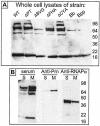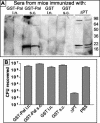Suppression of serum antibody responses by pertussis toxin after respiratory tract colonization by Bordetella pertussis and identification of an immunodominant lipoprotein
- PMID: 15155640
- PMCID: PMC415701
- DOI: 10.1128/IAI.72.6.3350-3358.2004
Suppression of serum antibody responses by pertussis toxin after respiratory tract colonization by Bordetella pertussis and identification of an immunodominant lipoprotein
Abstract
Pertussis toxin (PT), a virulence factor secreted by Bordetella pertussis, contributes to respiratory tract infection and disease caused by this pathogen. By comparing a wild-type (WT) B. pertussis strain to a mutant strain with an in-frame deletion of the ptx genes encoding PT (DeltaPT), we recently found that the lack of PT confers a significant defect in respiratory tract colonization in mice after intranasal inoculation. In this study, we analyzed serum antibody responses in mice infected with the WT or DeltaPT strain and found that infection with the DeltaPT strain elicited greater responses to several B. pertussis antigens than did infection with the WT, despite the lower colonization level achieved by the DeltaPT strain. The same enhanced antibody response was observed after infection with a strain expressing an enzymatically inactive PT; but this response was not observed after infection with B. pertussis mutant strains lacking filamentous hemagglutinin or adenylate cyclase toxin, nor when purified PT was administered with the DeltaPT inoculum, indicating a specific role for PT activity in this immunosuppressive effect. In particular, there were consistent strong serum antibody responses to one or more low-molecular-weight antigens after infection with the DeltaPT strain. These antigens were Bvg independent, membrane localized, and also expressed by the closely related pathogens Bordetella parapertussis and Bordetella bronchiseptica. Two-dimensional gel electrophoresis and mass spectrometry were used to identify one of the immunodominant low-molecular-weight antigens as a protein with significant sequence homology to peptidoglycan-associated lipoprotein in several other gram-negative bacterial species. However, a serum antibody response to this protein alone did not protect mice against respiratory tract infection by B. pertussis.
Figures







References
-
- Allen, A., and D. Maskell. 1996. The identification, cloning and mutagenesis of a genetic locus required for lipopolysaccharide biosynthesis in Bordetella pertussis. Mol. Microbiol. 19:37-52. - PubMed
-
- Bagley, K. C., S. F. Abdelwahab, R. G. Tuskan, T. R. Fouts, and G. K. Lewis. 2002. Pertussis toxin and the adenylate cyclase toxin from Bordetella pertussis activate human monocyte-derived dendritic cells and dominantly inhibit cytokine production through a cAMP-dependent pathway. J. Leukoc. Biol. 72:962-969. - PubMed
-
- Brennan, M. J., J. L. David, J. G. Kenimer, and C. R. Manclark. 1988. Lectin-like binding of pertussis toxin to a 165-kilodalton Chinese hamster ovary cell glycoprotein. J. Biol. Chem. 263:4895-4899. - PubMed
Publication types
MeSH terms
Substances
Grants and funding
LinkOut - more resources
Full Text Sources
Molecular Biology Databases

